| dc.contributor.author | Kismul, Hallgeir | en_US |
| dc.contributor.author | Schwinger, Catherine | en_US |
| dc.contributor.author | Chhagan, Meera | en_US |
| dc.contributor.author | Mapatano, Mala | en_US |
| dc.contributor.author | Van den Broeck, Jan | en_US |
| dc.date.accessioned | 2014-10-10T10:04:10Z | |
| dc.date.available | 2014-10-10T10:04:10Z | |
| dc.date.issued | 2014-01-28 | eng |
| dc.identifier.issn | 1471-2431 | |
| dc.identifier.uri | https://hdl.handle.net/1956/8628 | |
| dc.description.abstract | Background: Longitudinal studies describing incidence and natural course of malnutrition are scarce. Studies defining malnutrition clinically [moderate clinical malnutrition (McM) marasmus, kwashiorkor] rather than anthropometrically are rare. Our aim was to address incidence and course of malnutrition among pre-schoolers and to compare patterns and course of clinically and anthropometrically defined malnutrition. Methods: Using a historical, longitudinal study from Bwamanda, DR Congo, we studied incidence of clinical versus anthropometrical malnutrition in 5 657 preschool children followed 3-monthly during 15 months. Results: Incidence rates were highest in the rainy season for all indices except McM. Incidence rates of McM and marasmus tended to be higher for boys than for girls in the dry season. Malnutrition rates increased from the 0–5 to the 6 – 11 months age category. McM and marasmus had in general a higher incidence at all ages than their anthropometrical counterparts, moderate and severe wasting. Shifts back to normal nutritional status within 3 months were more frequent for clinical than for anthropometrical malnutrition (62.2-80.3% compared to 3.4-66.4.5%). Only a minority of moderately stunted (30.9%) and severely stunted children (3.4%) shifted back to normal status. Alteration from severe to mild malnutrition was more characteristic for anthropometrically than for clinically defined malnutrition. Conclusions: Our data on age distribution of incidence and course of malnutrition underline the importance of early life intervention to ward off malnutrition. In principle, looking at incidence may yield different findings from those obtained by looking at prevalence, since incidence and prevalence differ approximately differ by a factor “duration”. Our findings show the occurrence dynamics of general malnutrition, demonstrating that patterns can differ according to nutritional assessment method. They suggest the importance of applying a mix of clinical and anthropometric methods for assessing malnutrition instead of just one method. Functional validity of characterization of aspects of individual nutritional status by single anthropometric scores or by simple clinical classification remain issues for further investigation. | en_US |
| dc.language.iso | eng | eng |
| dc.publisher | BioMed Central | eng |
| dc.relation.ispartof | <a href="http://hdl.handle.net/1956/10986" target="blank">Determinants of child malnutrition. Studies from a rural area in the Democratic Republic of Congo</a> | |
| dc.rights | Attribution CC BY | eng |
| dc.rights.uri | http://creativecommons.org/licenses/by/2.0 | eng |
| dc.subject | Stunting | |
| dc.subject | Incidence | |
| dc.subject | Malnutrition | eng |
| dc.subject | Marasmus | eng |
| dc.subject | Kwashiorkor | eng |
| dc.subject | Wasting | eng |
| dc.title | Incidence and course of child malnutrition according to clinical or anthropometrical assessment: a longitudinal study from rural DR Congo | en_US |
| dc.type | Peer reviewed | |
| dc.type | Journal article | |
| dc.date.updated | 2014-02-06T04:03:37Z | |
| dc.description.version | publishedVersion | en_US |
| dc.rights.holder | Hallgeir Kismul et al.; licensee BioMed Central Ltd. | |
| dc.rights.holder | Copyright 2014 Kismul et al.; licensee BioMed Central Ltd. | |
| dc.source.articlenumber | 22 | |
| dc.identifier.doi | https://doi.org/10.1186/1471-2431-14-22 | |
| dc.identifier.cristin | 1159006 | |
| dc.source.journal | BMC Pediatrics | |
| dc.source.40 | 14 | |

